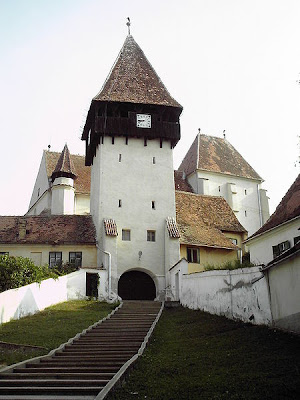Călimăneşti-Căciulata, often known just as Călimăneşti, is a town in the central-southern part of Romania (Vîlcea county), on the Olt River, in Jiblea - Călimăneşti Depression, at 260m altitude. It is situated on the traditional route connecting the region to Transylvania, and at the southern end of the Olt River valley crossing the Southern Carpathians, 18km N of the municipality of Rîmnicu-Vîlcea (seat of Vîlcea county). The climate is characteristic of the sheltered Sub-Carpathian hollows, without temperature contrasts, with cool summers (July average around 20°C) and rather mild winters (January average 1.5°C below); average annual temperature is 9.8°C, moderate precipitation (750-800 mm annually). The town is build along National Road 7 (DN7), the second most used road in Romania.

There are proofs that the mineral waters of Călimăneşti-Căciulata were used since the Roman times. The Romans built here fortifications and baths (Pons Vetus Castrum). Călimăneşti and Căciulata are documentary attested in 1388. Later, the monks from Cozia Monastery built here a place for treatment. Two great rulers of Wallachia, Mircea cel Batrân and Matei Basarab, came here to treat themselves. In the 17th century, was founded here a paper mill. The French doctor Joseph Caillat, who took temporary residence in Wallachia (1854), analyzed the Călimăneşti mineral waters in 1859, and in 1869 Napoleon III was on a cure of mineral water sent over from Călimăneşti. In 1893, the samples of mineral water from Călimăneşti-Căciulata won the gold medal at the
International Foods and Mineral Waters Exhibition in Brussels. The first cure establishments are dated 1910. During the 20th century, many hotels and treatment facilities were built in Căciulata, a northern area of the town which is close to Cozia Monastery. The area around the town is full of fresh water springs and spa waters that are not in use.

Călimăneşti-Căciulata is known as a spa town, an all-season resort of national importance. The natural cure factors are the sparing climate and the springs (discovered in 1827) of sulphurous, chlorided, brominated, sodic, calcic, magnesian, mostly hypotonic mineral waters, with varying concentrations, chemical compositions and temperatures (mineralization between 0.5 and 11.5 g/l; athermal, mesothermal = 41°C, and hyperthermal = 49.5°C). The spa is recommended for the treatment of digestive diseases (chronic gastritis with hypoacidity, chronic constipation, chronic colitis), hepatobiliary diseases (biliary dyskinesis, non-calculous or calculous chronic cholecystitis, chronic hepatitis, chronic pancreatitis, conditions after operations of the liver), kidney and urinary system diseases (kidney lithiasis, chronic pyelonephritis, urinary infections), metabolic and nutrition disorders (diabetes mellitus, hyperuricemic condittions, obesity), respiratory diseases (bronchitis, chronic tracheobronchitis), peripheral neurological disorders (paresis, conditions after proliomyelitis), rheumatic conditions (spondylosis, arthrosis, polyarthrosis, tendonitis), post-traumatic conditions (after sprains, luxations, fractures), gynecological disorders (menopausal ovarian syndrome), ear, nose and throat diseases (chronic rhinosinusitis, chronic allergic laryngitis, etc.), dermatological, cardiovascular and other disorders.

The present-day facilities include modern installations for warm mineral-water baths in tubs and pools, for electrohydro-, and kinetotherapy, for aerosols and inhalations, outdoor pools with sulphurous thermal water (at Căciulata), mineral water fountains for internal cure, gyms, sauna, swimming pool on the bank of the Olt, etc. At Căciulata there are a sanatorium for children, specialized in the treatment of hepatitis sequels, and the country's only sanatorium for silicosis patients; at Calimanesti there is a clinic of the
Bucharest Institute of Balneophysiotherapy and Medical Recovery, and a section of the specialized department of the
Bucharest Institute of Medicine and Pharmacy. Bottling station for mineral waters. (
internet infos compilation)











